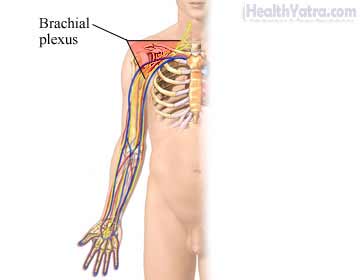Definition
A burner is an injury to the bundle of nerves in your neck. These nerves run from the back of your neck into your arm. The nerves leave the spine and form a group called the brachial plexus. The plexus extends into the upper shoulder. From here, the nerves split into individual strings. The nerve strings go to all the arm muscles. A burner may also be called a stinger.

Causes
A burner may be caused by injury to the brachial plexus, such as:
- Overstretching—can be caused by your shoulder being pushed down while your head is forced to the other side.
- Pinching— can happen if your head is moved quickly to one side.
- Bruising—can happen when the area above your collarbone is hit directly or pressure on the top of your head compresses the brachial plexus nerves against bone.
Risk Factors
Factors that increase your risk for a burner include:
- Playing American football—increase chance of receiving direct blows to the head, neck, and shoulders
- Participating in contact sports
Symptoms
Symptoms may include:
- Numbness, tingling, or weakness in the shoulder or arm
- Burning or stinging feeling in one arm
- Burning or stinging feeling between your neck and shoulder
Diagnosis
The doctor will ask about your symptoms and how the injury occurred. One of the most important questions is whether symptoms occur in one arm only or in both arms at the same time. Symptoms in more than one limb may be more serious. This may need more extensive evaluation.
The doctor will examine you for:
- Pain or tenderness
- Neck and arm range of motion
- Strength in the arm and hand
- Arm reflexes
- Sensation in the shoulder and hand
For serious burners you may have an electromyogram (EMG). This is a test of the electrical activity of the muscle. It can help to determine the extent of the injury.
It is important to make sure symptoms are due to burners and not a more serious injury to the spinal cord. Early recognition of this condition can prevent reinjury and possible paralysis. Careful post-injury evaluation can help prevent permanent damage.
Treatment
Some burners last only a few minutes. These will not need medical treatment.
Other burners may last longer. This can cause weakness in the muscle. Your doctor may recommend physical therapy. The therapist will help you strengthen your muscles while the nerve heals.
The decision to return to a sport activity after a burner requires careful evaluation. It is important that the nerve has fully healed and there is a low chance of reinjury. Some sports physicians will want an MRI or EMG study. Multiple burner injuries in one season may be reason to restrict return to play. In this case the player should consult an experienced sports medicine physician for evaluation.
Prevention
Steps that may help you avoid burner include:
- Keeping the muscles around your neck and shoulders strong and flexible will help you withstand the stress of a direct blow.
- Learning safe sports technique is essential.
- Avoid using your helmet as a contact point when tackling and blocking in football.
- Always make sure to wear the proper safety equipment for your sport.
- Pads and other modifications of athletic gear have been proposed in an effort to reduce the incidence of burners. These may be especially useful for players who have previously suffered injury.
